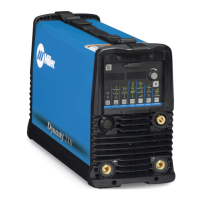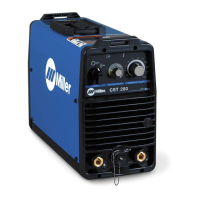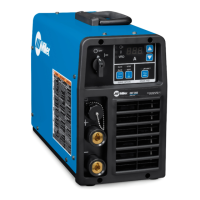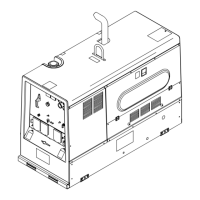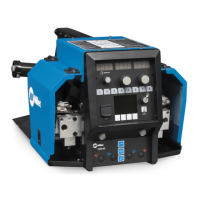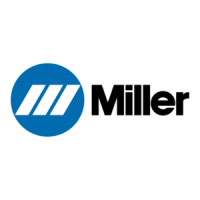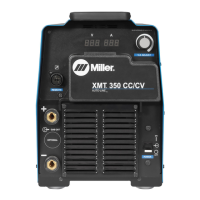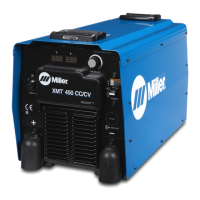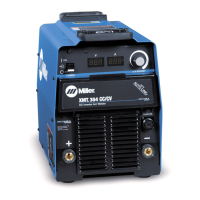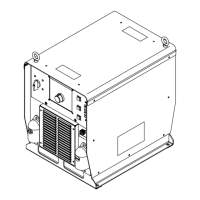Do you have a question about the Miller CP-302 and is the answer not in the manual?
Explains the meaning of various symbols used in the manual to indicate hazards.
Details hazards associated with arc welding, including electric shock, fumes, gases, and flying metal.
Discusses the dangers of inhaling welding fumes and gases and proper ventilation.
Explains the risks of arc rays and the need for protective gear like helmets and glasses.
Covers fire and explosion risks from welding sparks, hot materials, and flammable substances.
Warns about eye injuries from flying metal, sparks, grinding, and chipping.
Highlights risks associated with compressed gas cylinders and confined spaces.
Advises individuals with medical implants to be cautious around welding operations due to EMF.
Warns about potential hearing damage from noise and recommends ear protection.
Details the hazards of compressed gas cylinders and proper handling procedures.
Provides precautions against fire and explosion risks during installation and operation.
Covers safe practices for lifting and moving equipment to prevent falling hazards.
Explains how overuse can lead to overheating and how to prevent it.
Warns about the danger of moving parts and the need to keep panels secured.
Emphasizes reading the manual and labels before operating the equipment.
Advises on protecting face and eyes from flying sparks and hot metal.
Covers precautions for handling electronic components to prevent electrostatic discharge damage.
Warns about potential injuries from welding wire, such as accidental trigger pulls or pointing the gun.
Advises against using the welder for charging batteries or jump-starting vehicles unless designed for it.
Explains potential interference from High-Frequency radiation and mitigation steps.
Discusses electromagnetic interference from arc welding and how to reduce it.
Provides warnings about chemicals in fumes and gases known to cause birth defects or cancer.
Lists key safety standards and organizations relevant to welding equipment.
Details information about Electric and Magnetic Fields (EMF) and precautions for users.
Explains the meaning of various symbols used in the manual to indicate hazards.
Defines common symbols used for input, output, on/off states, and percentage values.
Describes the location of the serial and rating information on the product.
Provides electrical specifications, including input power and output ratings for various voltages.
Details operating and storage temperature ranges for the equipment.
Explains duty cycle, overheating protection, and how to prevent damage from exceeding limits.
Illustrates the minimum and maximum voltage and amperage output capabilities of the unit.
Lists the physical dimensions and weight of the welding power source.
Provides guidance on choosing a suitable location for the welding unit, considering movement and airflow.
Shows a diagram for connecting a MIG wire feeder to the power source.
Explains how to select and adjust inductance for optimal weld bead characteristics.
Provides a guide for selecting appropriate weld cable sizes based on amperage and cable length.
Identifies the positive and negative weld output terminals and safety precautions.
Details the correct procedure for connecting weld output cables to the terminals.
Explains the function of the Remote 14 receptacle and its various sockets.
Describes how to connect the unit to a 115V AC duplex receptacle.
Provides recommendations for electrical service requirements, including input voltage and conductor sizes.
Explains how to position jumper links to match the available input voltage.
Details the procedure for connecting the unit to a 3-phase input power supply.
Continues the instructions for connecting 3-phase input power, including safety and code compliance.
Identifies and explains the function of the various controls on the welding power source.
Outlines a schedule for routine maintenance tasks, including checks, cleaning, and replacements.
Explains the overload protection system, including fuses, and how to replace them.
Provides a table of common problems and their corresponding remedies for troubleshooting.
Presents the detailed electrical circuit diagram for the welding power source.
Explains the meaning of various symbols used in the manual to indicate hazards.
Details hazards associated with arc welding, including electric shock, fumes, gases, and flying metal.
Discusses the dangers of inhaling welding fumes and gases and proper ventilation.
Explains the risks of arc rays and the need for protective gear like helmets and glasses.
Covers fire and explosion risks from welding sparks, hot materials, and flammable substances.
Warns about eye injuries from flying metal, sparks, grinding, and chipping.
Highlights risks associated with compressed gas cylinders and confined spaces.
Advises individuals with medical implants to be cautious around welding operations due to EMF.
Warns about potential hearing damage from noise and recommends ear protection.
Details the hazards of compressed gas cylinders and proper handling procedures.
Provides precautions against fire and explosion risks during installation and operation.
Covers safe practices for lifting and moving equipment to prevent falling hazards.
Explains how overuse can lead to overheating and how to prevent it.
Warns about the danger of moving parts and the need to keep panels secured.
Emphasizes reading the manual and labels before operating the equipment.
Advises on protecting face and eyes from flying sparks and hot metal.
Covers precautions for handling electronic components to prevent electrostatic discharge damage.
Warns about potential injuries from welding wire, such as accidental trigger pulls or pointing the gun.
Advises against using the welder for charging batteries or jump-starting vehicles unless designed for it.
Explains potential interference from High-Frequency radiation and mitigation steps.
Discusses electromagnetic interference from arc welding and how to reduce it.
Provides warnings about chemicals in fumes and gases known to cause birth defects or cancer.
Lists key safety standards and organizations relevant to welding equipment.
Details information about Electric and Magnetic Fields (EMF) and precautions for users.
Explains the meaning of various symbols used in the manual to indicate hazards.
Defines common symbols used for input, output, on/off states, and percentage values.
Describes the location of the serial and rating information on the product.
Provides electrical specifications, including input power and output ratings for various voltages.
Details operating and storage temperature ranges for the equipment.
Explains duty cycle, overheating protection, and how to prevent damage from exceeding limits.
Illustrates the minimum and maximum voltage and amperage output capabilities of the unit.
Lists the physical dimensions and weight of the welding power source.
Provides guidance on choosing a suitable location for the welding unit, considering movement and airflow.
Shows a diagram for connecting a MIG wire feeder to the power source.
Explains how to select and adjust inductance for optimal weld bead characteristics.
Provides a guide for selecting appropriate weld cable sizes based on amperage and cable length.
Identifies the positive and negative weld output terminals and safety precautions.
Details the correct procedure for connecting weld output cables to the terminals.
Explains the function of the Remote 14 receptacle and its various sockets.
Describes how to connect the unit to a 115V AC duplex receptacle.
Provides recommendations for electrical service requirements, including input voltage and conductor sizes.
Explains how to position jumper links to match the available input voltage.
Details the procedure for connecting the unit to a 3-phase input power supply.
Continues the instructions for connecting 3-phase input power, including safety and code compliance.
Identifies and explains the function of the various controls on the welding power source.
Outlines a schedule for routine maintenance tasks, including checks, cleaning, and replacements.
Explains the overload protection system, including fuses, and how to replace them.
Provides a table of common problems and their corresponding remedies for troubleshooting.
Presents the detailed electrical circuit diagram for the welding power source.
| Brand | Miller |
|---|---|
| Model | CP-302 |
| Category | Welding System |
| Language | English |
